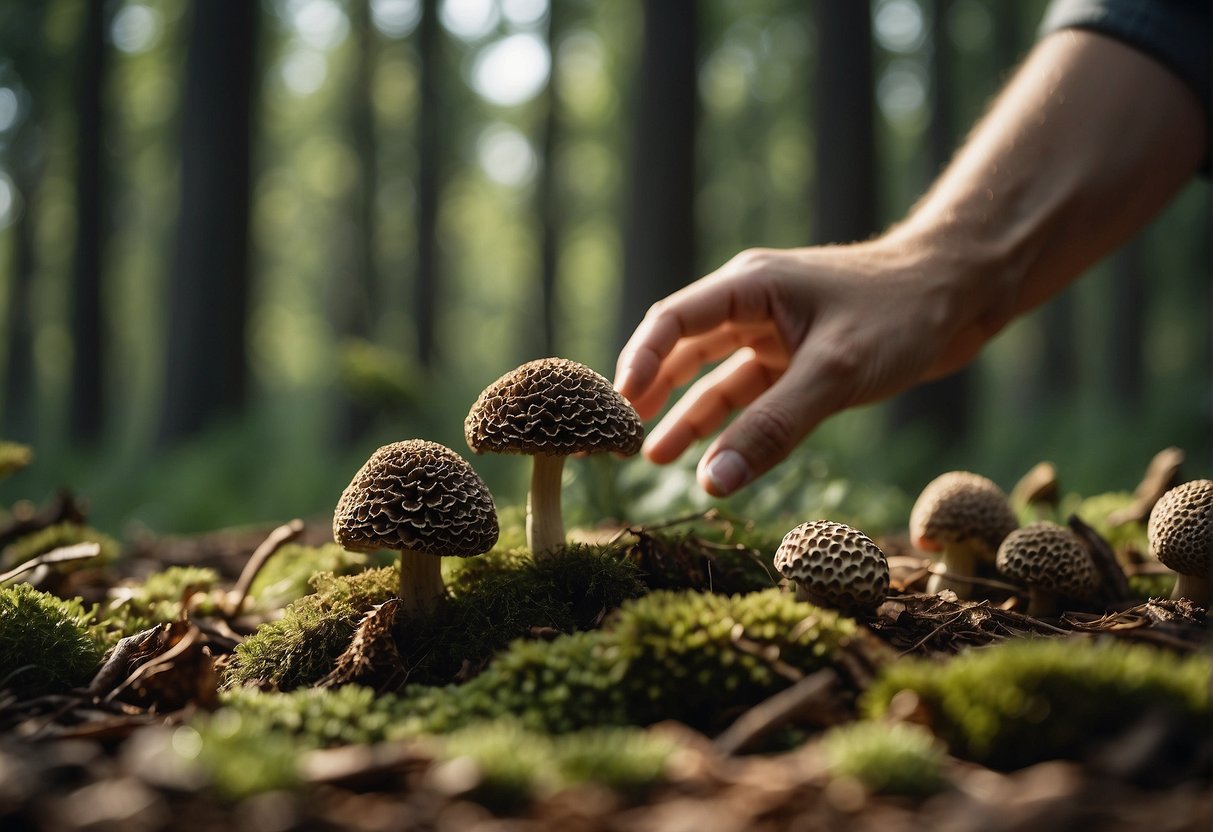As you venture into the lush forests come springtime, keep your eyes peeled for the coveted morel mushrooms. These distinct fungi are not only a forager’s delight but also a gourmet’s treasure. Morels have a unique honeycomb appearance which makes them easily identifiable amidst the forest floor’s undergrowth. Their earthy, nutty flavor is highly prized in the culinary world, and finding them can be both a challenging and rewarding experience. Fresh morel mushrooms emerge with the arrival of spring warmth, aligning with the time when the soil is moist, making it the prime season to seek them out.

Understanding where to look for morels can enhance your foraging trips. These mushrooms flourish in woodland areas, particularly where ash, elm, and apple trees are abundant. They often grow in burn sites where fires have occurred in previous years. The thrill of hunting for morels is akin to a treasure hunt, where each find feels like a triumph. When you do discover them, it’s important to harvest them carefully to preserve their delicate structure.
Purchasing fresh morels can be an investment due to their short season and the labor-intensive process of foraging. However, the taste of fresh morels, sautéed simply with butter and a pinch of salt, justifies the effort. If you’re not inclined to forage yourself, there are reputable sources where you can buy morel mushrooms, ensuring you get to experience the unique flavor that these springtime mushrooms have to offer. Whether you’re a seasoned forager or a curious culinary enthusiast, morels present an annual pursuit to delight in nature’s bounty.
Buying Guide for Morel Mushrooms
When you’re looking to purchase morel mushrooms, understanding the varieties available, assessing their freshness and quality, and choosing between fresh and dried options are crucial steps to ensuring you get the best out of your purchase.
Understanding Morel Varieties
Morels are treasured wild mushrooms with distinctive flavors and textures that vary across their types. Yellow morels are known for their lighter flavor, while black morels have a stronger taste. Blonde morels, a variation of yellow morels, and the common morel are highly sought after. Ensure you’re informed about false morels, which are not safe for consumption. Foraging for morels can be an adventurous activity, but always confirm your finds with an expert to ensure they are true, edible morels.
Determining Freshness and Quality
- Freshness: Look for morels that are firm to the touch with a springy consistency. Avoid morels that are soft, shriveled, or have visible slime, which indicates they are past their prime.
- Quality: True morels should have a hollow stem and cap; if they’re not hollow, they might be false morels. Fresh morels are best consumed soon after harvesting for optimal taste and texture.
Choosing Between Fresh and Dried Morels
- Fresh Morels: Offer an incomparable taste and are ideal for immediate use. They should be used within a few days of purchase and can add an unmatched woodsy flavor to your dishes.
- Dried Morel Mushrooms: Are a convenient option and can be stored for extended periods. Rehydrate them by soaking in warm water to regain a texture close to that of fresh morels. Dried morels are a good alternative when out-of-season or for adding depth to soups and sauces.
Preparing and Storing Morels
As a lover of the great outdoors and the delicacies it provides, it’s important to know how to handle your morel mushrooms from the forest to the kitchen. Mastering techniques for cleaning, storing, and rehydrating morels will ensure that you maintain their distinctive flavor and texture.
Cleaning and Handling Fresh Morels
Begin by gently brushing off any loose dirt from your morels with a soft brush; they’re delicate, so handle them with care. Soaking is also an option to clean them thoroughly: place your morels in a bowl of cold water, agitate gently, and remove quickly to avoid waterlogging. After cleaning, pat them dry with a paper towel and move on to storing them properly.
Proper Storage Techniques
To store morels in the refrigerator, place them in a paper bag, which allows the mushrooms to “breathe” and helps retain texture. Steer clear of plastic bags as they trap moisture and can lead to spoilage. Morels can be kept in the fridge for up to a week. For long-term keeping, store cleaned morels in an airtight container or freezer bag and freeze them; they can last for months this way. Sautéing morels in butter before freezing can add an extra layer of flavor.
Rehydrating Dried Morels
When you’re ready to use dried morels, rehydration is key. Place the dried morels in a bowl and pour warm water over them, allowing them to soak for 20-30 minutes. They should regain their shape and texture. Remember, you can use the flavorful soaking liquid in your cooking as well, just make sure to strain any residual grit through a fine sieve.
By taking the time to clean and store your morels properly, you’ll be able to enjoy their unique taste and texture long after your foraging adventure.
Cooking with Morel Mushrooms
Exploring the culinary world of morel mushrooms opens up a spectrum of flavors from earthy to umami. Whether you’re just getting your boots dirty in the kitchen or you’re an experienced chef, there’s a place for morels in your skillet.
Simple Morel Recipes for Beginners
Starting with the basics, your first adventure with morels should be simple to let their natural, woodsy taste shine. Begin with:
- Sautéed Morels:
- Clean your morels gently and slice them in half lengthwise.
- Heat a pan with butter on medium heat.
- Add morels, salt, and a bit of garlic.
- Cook until they’re golden brown, usually taking 3-5 minutes per side.
You’ll find that the caps bring a great texture to dishes, while the stems deliver an intense earthiness. And don’t toss those trimmings; they make a fantastic sauce when simmered with cream and thyme.
Advanced Techniques for Experienced Chefs
If you’re comfortable with your culinary chops, it’s time to let morels play a lead role in sophisticated dishes. Try incorporating morels into a risotto to bring a creamy texture with an earthy and umami flavor. Here’s what you can do to intensify the flavors:
- Smoke your morels before adding them to the recipe for added smokiness.
- Deglaze the pan with a splash of white wine after browning the morels.
- Layer flavors by cooking morels with complementary ingredients like onions and garlic.
Pairing Morels with Other Ingredients
Pairing morels with the right ingredients can elevate a simple dish to a memorable meal. Complement morels with other ingredients that share their earthy qualities, or contrast them with lighter flavors. Here are some pairing ideas:
- Pasta: Toss morels with fettuccine, garlic, and parsley for a quick feast.
- Soups: Create a hearty blend with morels, leeks, and potatoes.
- Meat: Pair morels with a nice cut of steak or venison for a satisfying, rustic dish.
Remember, the key to nailing that perfect blend of flavors is balancing the morel’s unique taste with your other chosen ingredients. The earthiness of morel mushrooms pairs wonderfully with the savory notes of meats, or even the subtle, creamy textures of risotto and pasta dishes.
Health Benefits and Safety Tips
When foraging or purchasing morel mushrooms, it’s essential to understand their health benefits and ensure you’re consuming them safely. Morels are a nutritious choice and can bolster your health but be aware of the look-alike varieties that could be harmful.
Nutritional Value of Morels
Morels are a treasure trove of nutrients, providing significant amounts of essential vitamins and minerals. They are particularly notable for their vitamin D content, which is crucial for bone health and immune system support. Besides vitamin D, morels are rich in B vitamins, which are essential for maintaining energy levels and proper brain function. They also offer a mix of minerals, including copper, zinc, potassium, and selenium. The nutty flavor of morel mushrooms makes them a delicious source of these nutrients.
Identifying and Avoiding Poisonous Varieties
It’s crucial to be able to differentiate between true morels and their toxic counterparts. Certified guides or experienced foragers can help ensure that the morels you find are safe to eat. Always check for hollow stems when identifying morels, as poisonous look-alikes often have solid or cottony-filled stems. Remember, if you’re ever in doubt, it’s best to leave the mushroom where it is.
Incorporating Morels into a Healthy Diet
Morels can be a great addition to your diet, not just for their unique nutty flavor, but also for their health benefits. Whether sautéed or added to recipes, morels can help enhance your meals. They can be included in stews, omelets, and pasta, adding both flavor and nutritional value. For those looking to eat organic, morels are a fantastic option, as they are often found in the wild and free from synthetic additives. Plus, the zinc and selenium found in morels are wonderful for boosting your immune system.


